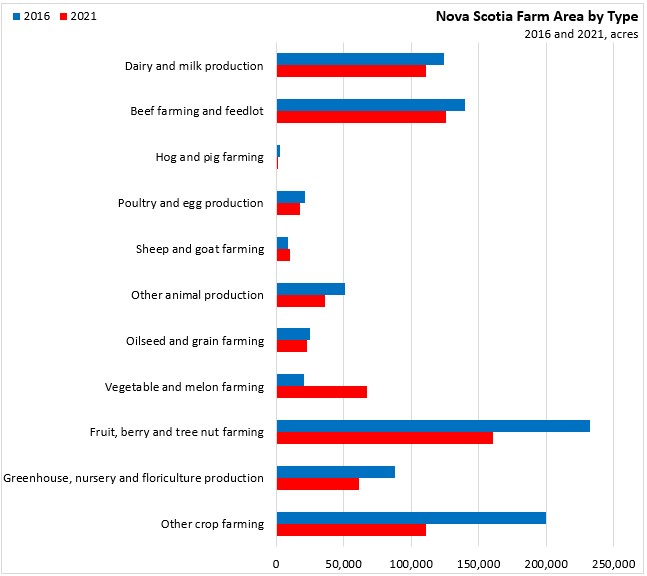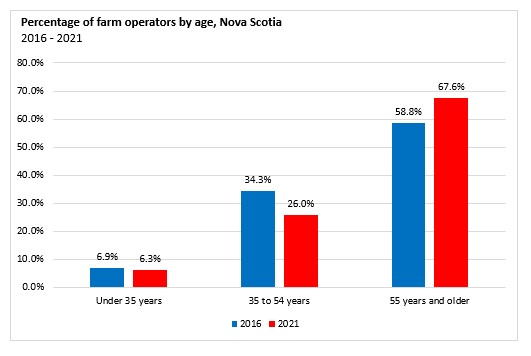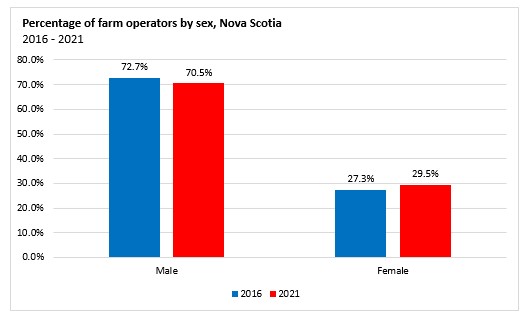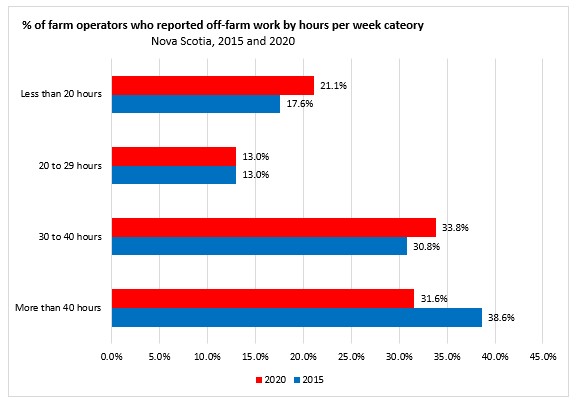The Economics and Statistics Division maintains archives of previous publications for accountability purposes, but makes no updates to keep these documents current with the latest data revisions from Statistics Canada. As a result, information in older documents may not be accurate. Please exercise caution when referring to older documents. For the latest information and historical data, please contact the individual listed to the right.
<--- Return to Archive
For additional information relating to this article, please contact:
July 14, 2022CENSUS OF AGRICULTURE: PROFILE OF NOVA SCOTIA FARMS Statistics Canada recently released results from the 2021 Census of Agriculture, which provides new information about emerging trends and issues faced by farm operators in Canada. Statistics Canada also released 11 articles profiling farm and farm operator trends in Canada's provinces and territories. These profile articles look at key trends from 2016 to 2021 and compare them against national totals. This article provides an overview of Nova Scotia farms.
In 2021, farms in Nova Scotia reported 725,738 acres in total farm area. This was a decline of 20.7% from 2016, a larger decline than the national average of -3.2%.
Farms classified as fruit and tree nut accounted for 22.1% of the province’s total farm area. This was followed by beef and feedlots (17.3%), dairy and milk (15.3%), and other crop farming (15.3%).
Within the total fruit and tree nut area, lowbush blueberries accounted for 80.3% of the total fruit area for the province, followed by 11.0% for apples and 2.6% for grapes in 2021.
In 2021, Nova Scotia farms reported the third largest lowbush blueberry area in Canada. Nova Scotia reported 35,814 acres of lowbush blueberry accounting for 22.0% of Canada’s total reported lowbush blueberry acreage.
Nova Scotia reported 4,924 acres of apples, the fourth largest apple acreage across provinces in 2021. From 2016 to 2021, apple acreage increased 11.5% in Nova Scotia while it declined by 0.6% nationally.
Nova Scotia reported 84,458 mink, the largest across Canada in 2021. Despite the 66.6% decline in the number of mink since 2016, Nova Scotia accounted for 35.8% of Canada’s total mink.

In 2020, Nova Scotia farms reported $722.1 million in farm operating revenues. This accounted for 0.8% of Canada’s total farm operating revenues.
Farms classified as poultry and egg production ($188.1 million) accounted for 26.1% of the province’s total farm operating revenues. This was followed by dairy and milk production ($177.9 million) and fruit and tree nut ($104.5 million) farms.
While fruit and tree nut farms accounted for 14.4% of farm operating revenues in Nova Scotia, they accounted for 2.2% of farm operating revenues in Canada in 2020.
Nova Scotia reported a total of 2,741 farms in 2021, a decline of 21.2% when compared to 2016. This was the largest decline across all provinces and above the national average of -1.9%. Farms classified as hog and pig had the biggest percentage decrease (-56.5%) from 2016 to 2021.
In 2021, 11.5% of Nova Scotia farms reported renewable energy production, similar to the national average of 11.9%. Compared to 2016 Census of Agriculture, the number of Nova Scotia farms reporting renewable energy production more than doubled.
In Nova Scotia, solar energy was the most frequently reported source of renewable energy production. 6.1% of Nova Scotia farms reported producing solar energy, up from 3.3% in 2016. By comparison, 7.6% of farms across Canada reported solar energy production in 2021.
In 2020, 30.3% of Nova Scotia farms reported direct sales, up from 23.6% in 2015. This was above the national average of 13.6% in Canada. Farms classified as beef and feedlots made up the largest portion (18.5%) of the 831 farms that reported direct sales in 2020 in Nova Scotia.
In 2020, 53.7% of farms in Nova Scotia reported selected land practices, up from 41.8% in 2015. This was below the national average of 64.5%.The most frequently reported land practice in the province was the use of shelterbelts or windbreaks. 40.4% of farms in Nova Scotia reported shelterbelts or windbreaks, up from 24.3% in 2015.
In 2021, 8.1% of farms in Nova Scotia reported a succession plan, up from 5.2% in 2016. This was below the national average of 12.0%.
Nova Scotia reported the highest average farm operator age in Canada in 2021. The average age of farm operators in the province increased from 56.5 years in 2016 to 58.2 years in 2021. In Nova Scotia, over two-thirds (67.6%) of farm operators were aged 55 years and older, which was above the national level (60.5%).

In 2021, the number of total farm operators (3,785) in Nova Scotia decreased by 18.3% from 2016. The decrease in the number of farm operators was quite similar to the decrease of 21.2% in the total number of farms in the province.
While the proportion of female operators in Nova Scotia increased from 27.3% in 2016 to 29.5% in 2021, it was still below the national average of 30.4%.

In Nova Scotia, the proportion of farm operators reporting working off the farm increased slightly from 44.7% in 2015 to 46.9% in 2020. Farm operators were less likely to work off farm part time (less than 30 hours per week) than full time (30 or more hours per week).

Source: Statistics Canada; Canadian Agriculture at a Glance: Lowbush blueberries, apples, mink and poultry play a large role in Nova Scotia farming
<--- Return to Archive